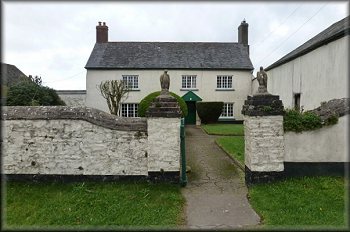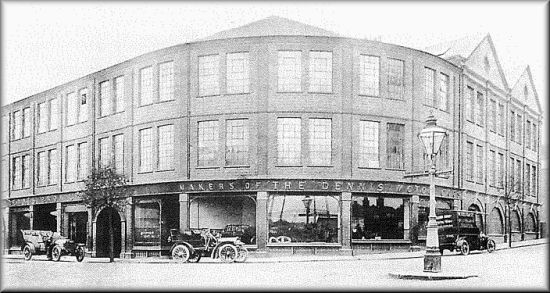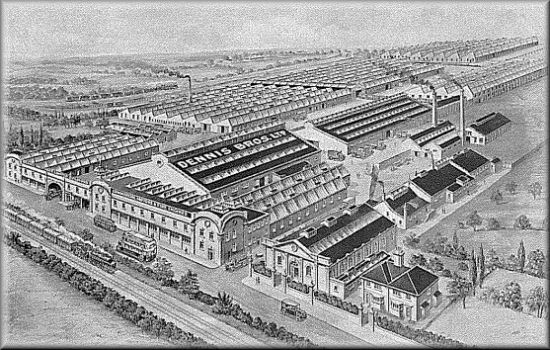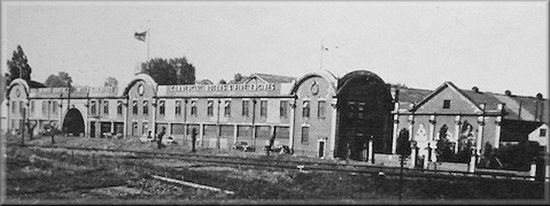- A Brief History of
- Dennis Bros of Guildford -
1895 to 2011

- John Dennis
- (1871–1939)
|

- Raymond Dennis
- (1878–1939)
|

- The Devon farmhouse where the Dennis brothers were brought up
- and lived before moving to Guildford.
- (Photographed in 2017)
- Early days
- John and Raymond Dennis were brought up in Huntshaw in Devon. John
then moved to Guildford where, whilst working for an ironmonger Filmer
& Masons, he started making bicycles in his spare time. These sold
at a profit and in 1895 he set up his own business, the Universal Athletic
Stores in Guildford High Street, selling bicycles and other sports goods.
Here he was joined by his brother Raymond and the enterprise expanded.
Bicycle manufacturing continued and other products were made were tricycles
and quadricycles. The first motorised vehicle built in 1898, was a tricycle
fitted with a single cylinder De Dion engine. This was followed by other
motorised vehicles with the first proper car being built in 1901. At about
this time, the business became a private limited company, Dennis Brothers
Limited. Technical development was a key aspect of the enterprise and an
early innovation was the worm drive rear axle which was used from 1903.
-

- 1901 Dennis moved into the new, purpose built Rodboro Buildings
and even this building was extended two years later to cope with the demand.
The first car was produced using the De Dion engine. Customers included
Brazilian Viscount and Russian Dukes!!
-
- 1904-1913
- The brothers were successful with their cars, competing in various
speed and endurance trials but realised that the market was limited. Cars
at that time were mostly bought by the gentry so they took the decision
to move into commercial vehicles, the first being made in 1904 - a 15 cwt
van for Harrods of London. This was soon followed by the first bus chassis,
fitted with a 28 hp Aster engine, which went to Benjamin Richardson. Like
other vehicles at this time, the engine and transmission were mounted on
a sub-frame to reduce stresses. The worm drive axle was patented in 1904.
-
 |
- 1904 15 cwt van for Harrods of London.
|
Production expanded and in 1908 Dennis made their first fire engine.
By 1909, over 400 staff were employed in the works. Commercial vehicle
production volume had overtaken that of cars in 1905 and in 1913 it was
decided to discontinue making cars and concentrate on commercial vehicles.
A range of goods chassis were made ranging from 15 cwt to 5 ton capacity
and these were fitted with either lorry or van bodywork for haulage work
or bodied as single or double deck buses.
- First World War
- The Government subsidy scheme had already begun by 1913 and Dennis
submitted the 3 ton lorry for approval. 7000 were built and other war work
comprised pumping sets, and a small number of lorries and buses for civilian
use and export.
-
- 1919-1939

- 1919 Rodboro building was sold to the Rodboro Boot and Shoe
company and the business moved to the Woodbridge Hill site where it remained
1990
Big changes following the war saw Dennis export business growing and
expanding into the field of municipal vehicles such as road sweepers and
vacuum gully emptiers. Lawn mower production started in 1922. Bus and lorry
chassis were updated and a typical double decker was offered on a 4- ton
chassis with seats for up to 48, 24 on each deck. Many were sold for use
in London.
During the time of economic depression, the diversity of products kept
the firm going and in 1925 they launched their first purpose-built low
framed forward control bus chassis. This was the E type and featured a
monoblock engine, unit mounted gearbox, underslung worm axle and pneumatic
tyres. The separate engine sub frame used in earlier models was discontinued
at this stage. Pneumatic tyres were introduced on single deckers in 1925
and were permitted on double deckers in 1928, many older chassis being
so converted.
 |
Dennis Brothers built their first lawnmower and production
continued throughout the 1930s attracting customers such as King George
V and King George VI
|
Lorry production was not buoyant during the years of the 30's depression,
but the firm kept going with its export business, fire engines, municipal
vehicles and passenger chassis.
- Second World War
- All bus production stopped and the Guildford works set about war production,
building 700 Churchill tanks, 4500 army lorries, and 3000 tracked personnel
carriers. At this time there were 3000 works staff. A few civilian lorries
were produced for the home market and these were fitted with utility design
of cabs.
-

- Woodbridge Hill site in Second World War
-
- 1945-1972
- Whilst the prospects for passenger vehicles and fire engines was good
after the war, the same could not be said for the goods vehicle side. One
of the new developments was the O6 diesel engine which gave 100bhp and
was offered in both double and single deck chassis, the revived and updated
Lance and Lancet. Both were available with the 5-speed overdrive gearbox,
giving the buses and coaches a good turn of speed, and the Lancet in particular
sold well in a market hungry for social travel.
Dennis had been slow in developing its own diesel engine in the 1930s
and although the front engined single deck chassis sold well in the 50s,
the development of a satisfactory underfloor engined bus chassis also lagged
behind that of other manufacturers. One was developed but sales were limited.
From 1957, Dennis offered a low height double deck chassis, this being
the Bristol Lodekka design built under licence. The licence agreement included
a 2-way exchange of technical information. Dennis developed the epicyclic
gearbox for this model and thus semi-automatic Bristol Lodekkas effectively
have Dennis transmission. Bus manufacture ceased in 1967.
- 1972-1990
- In the early 1970s, the business once again concentrated on exports.
The company was bought by the Hestair group and was re-named Hestair-Dennis.
A rationalisation of models on offer led to a recovery with significant
earnings from the export business. By the mid-70s, Dennis were ready once
again to offer both goods vehicles and buses on the domestic market. The
bus industry was seeking an alternative rear engined double decker and
the Dominator was developed, utilising a Gardner engine and Voith retarder
transmission. This was sold both at home and overseas, being supplemented
in the export market by a front engined version, the Jubilant. Eventually
larger overseas chassis were also produced, the Condor and Dragon being
6-wheel chassis derived from the Dominator design and capable of carrying
172 seat bodywork.
-
- 1989-1995
- In 1989, the Hestair vehicle interests were sold to Trinity Holdings,
a new company set up by directors from the vehicle groups. By this time,
Dennis (now known as Dennis Specialist Vehicles) were offering a range
of bus and coach chassis comprising the Dominator, Jubilant, Condor, Dragon,
Falcon, Lancet and Dorchester as well as fire engines. Municipal vehicle
production had by then been moved to the 'Eagle' site in Warwick and cab
production was relocated to Blackpool. In 1991 the Guildford factory was
focussing on psv and fire engine chassis and production was moved from
Woodbridge Road to a new facility on an industrial estate at Slyfield.
-

- In 1990 A purpose built factory was planned and opened in
1990
- with a workforce of 317
The fact that Dennis are still manufacturing vehicles and have been
doing so for over 100 years is an industrial success story by any standards.
Much has been written over the years about this success. Not all has been
plain sailing, of course, and the hallmark of many a business is to explore
openings as they arise, to build on the successes and drop the less successful.
The business always benefited from technical innovation and Dennis were
pioneers of many engineering developments. To this was added the policy
of product diversification and this carried the business through a range
of periods of boom and depression. By diversifying into a number of specialist
markets and by being ready to promote exports, the business has survived
and prospered.
- 1995 -2011
- In 1998 Trinity Holdings was then bought out by the Mayflower Corporation
and in 2001TransBus International was created employing 2,000 employees
within the Group.
In 2004 TransBus International went into Administration and Alexander
Dennis Limited (ADL) was established. A consortium of business entrepeneurs,
led by Noble Grossart, Merchant Bankers; the Bank of Scotland; Brian Souter
from Stagecoach and his sister Ann Gloag, together with the Chairman of
Glasgow Rangers, David Murray, acquired the major part of the business
previously held by TransBus International.
The acquisition of Plaxton Holdings Limited in 2007 by ADL created Britain’s
largest bus and coach manufacturing operation, providing a platform for
entry into new European and global markets.

Click to see Alexander Dennis Website
(Will open new window or tab) |

